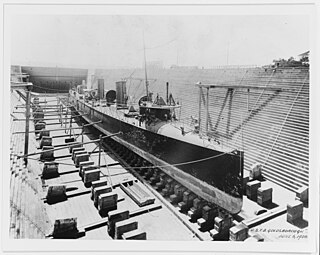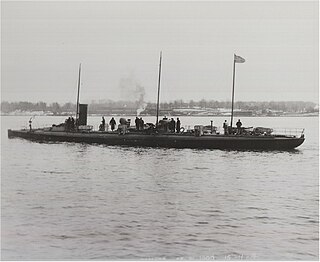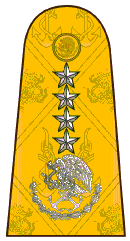A naval militia or maritime militia is a volunteer organization comprising civilian sailors who train periodically to support naval operations during emergencies or times of war.

The Royal Navy (RN) is the naval warfare force of the United Kingdom, British Overseas Territories and Crown Dependencies, and a component of His Majesty's Naval Service. Although warships were used by English and Scottish kings from the early medieval period, the first major maritime engagements were fought in the Hundred Years' War against France. The modern Royal Navy traces its origins to the English Navy of the early 16th century; the oldest of the UK's armed services, it is consequently known as the Senior Service.
Mast, MAST or MASt may refer to:

While the defence of Bermuda remains the responsibility of the government of the United Kingdom, rather than of the local Bermudian Government, the island still maintains a militia for the purpose of defence.

In the United States, state defense forces (SDFs) are military units that operate under the sole authority of a state government. State defense forces are authorized by state and federal law and are under the command of the governor of each state.

USS Underwood (FFG-36) was the twenty-seventh ship of the Oliver Hazard Perry-class of guided-missile frigates, named for Captain Gordon Waite Underwood (1910–1978).
Admiralty most often refers to:

A naval militia is a reserve military organization administered under the authority of a state government in the United States. It is often composed of reservists of the Navy Reserve, Marine Corps Reserve, and Coast Guard Reserve, retirees and volunteers. They are distinguishable from the U.S. Coast Guard Auxiliary which is a federally chartered civilian volunteer component of the U.S. Coast Guard and falls under the command of the Commandant of the Coast Guard through the Chief Director of the Auxiliary, and the United States Maritime Service and United States Merchant Marine, both of which are federal maritime services.

Federalist No. 74 is an essay by Alexander Hamilton, the seventy-fourth of The Federalist Papers. It was published on March 25, 1788, under the pseudonym Publius, the name under which all The Federalist papers were published. Its title is "The Command of the Military and Naval Forces, and the Pardoning Power of the Executive", and it is the eighth in a series of 11 essays discussing the powers and limitations of the Executive branch.

USNS Mission Los Angeles (T-AO-117) was a Mission Buenaventura-class oiler that served in the United States Navy. The ship was originally intended as USS Conecuh (AO-103) for the U.S. Navy but her acquisition was canceled. The ship, a Type T2-SE-A3 tanker, was completed as SS Mission Los Angeles and delivered after the end of World War II. The tanker was acquired by the U.S. Navy in 1948 as USS Mission Los Angeles (AO-117), but was transferred to the Military Sea Transport Service upon its creation in 1949. The ship was named for Nuestra Señora Reina de los Angeles Asistencia, she was the only U.S. Naval Vessel to bear the name.

Bermuda has organised several different forms of militia between the 1612 and 1815. The roles of the militias included defence of the colony in complement with the activities of the British Army and Royal Navy.
Bermuda Militia, under Militia Acts 1687–1813. Although the Bermuda Parliament had been formed in 1620, prior to 1687, the Bermudian Militia was raised and organised without reference to a Militia Act. The Crown took over the administration of the Colony from The Somers Isles Company in 1684.

The first USS Goldsborough was a torpedo boat in the United States Navy during World War I. She was named for Louis M. Goldsborough.

The third USS Somers, a steel torpedo boat built as a private speculation by Friedrich Schichau, Elbing, Germany, was launched in 1897 as yard No. 450; purchased for the United States Navy on 25 March 1898; commissioned on 28 March 1898 and named Somers the next day.
Combined Task Force Iraqi Maritime or CTF IM was an international naval task group, established as a result of Operation Iraqi Freedom. It consisted of naval assets from the United States Navy and Coast Guard, the Royal Australian Navy and the Royal Navy, working alongside elements of the Iraqi Navy and the Iraqi Marines. It reported to the Coalition Maritime Component Commander in Bahrain.
The Portuguese Legion was a Portuguese paramilitary state organization founded in 1936 during the Portuguese President of the council's António de Oliveira Salazar's right-wing dictatorship, the Estado Novo. It was dissolved by law on April 25, 1974.

The Mexican Secretary of the Navy is a member of the federal executive cabinet as well as the highest-ranking Mexican naval officer with the responsibility of commanding the Mexican Navy and managing the Secretariat of the Navy. The secretary is appointed by the President of the Republic.
USNS Sgt. Morris E. Crain (T-AK-244) was a Boulder Victory-class cargo ship built at the end of World War II and served in the war prior to its demilitarization as a commercial cargo vessel. From post-war to 1950 she served the U.S. Army as a transport named USAT Morris E. Crain. In 1950 she was acquired by the U.S. Navy and assigned to the Military Sea Transportation Service. In 1975 she ended her career and was placed into reserve.
The Illinois Naval Militia was a naval militia created by the Illinois General Assembly in 1893, and finally dissolved in 1988. The naval militia was reauthorized by Governor Rod Blagojevich through an executive order in 2006. As a naval militia it was a state defense force and not part of the Illinois National Guard or National Guard of the United States.

The South Carolina Naval Militia (SCNM) is the naval militia of the state of South Carolina. The SCNM is a naval unit organized at state level and primarily composed of Navy and Marine Corps reservists who serve simultaneously as federal and state level reservists. The SCNM can be deployed by the Governor of South Carolina to assist in emergency response or in homeland security operations.

The Chinese Maritime Militia, also called the People's Armed Force Maritime Militia (PAFMM) or Fishery Militia (渔政民兵), is a naval militia of the People's Republic of China (PRC). It is the smallest of the three maritime forces used in Chinese sea patrol operations, next to the China Coast Guard (CCG) and the People's Liberation Army Navy (PLAN).